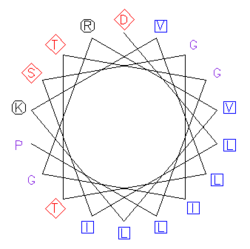Helical wheel

A helical wheel is a type of plot or visual representation used to illustrate the properties of alpha helices in proteins. The sequence of amino acids that make up a helical region of the protein's secondary structure are plotted in a rotating manner where the angle of rotation between consecutive amino acids is 100°, so that the final representation looks down the helical axis. The plot reveals whether hydrophobic amino acids are concentrated on one side of the helix, usually with polar or hydrophilic amino acids on the other. This arrangement is common in alpha helices within globular proteins, where one face of the helix is oriented toward the hydrophobic core and one face is oriented toward the solvent-exposed surface. Specific patterns characteristic of protein folds and protein docking motifs are also revealed, as in the identification of leucine zipper dimerization regions and coiled coils.
External links
- Less traditional, more colorful wheels (requires Macromedia Flash)
References
- Mount DM (2004). Bioinformatics: Sequence and Genome Analysis (2 ed.). Cold Spring Harbor, NY: Cold Spring Harbor Laboratory Press. ISBN 0-87969-712-1.